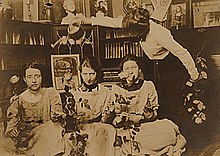 Plastic Club members in their early
Chestnut Street studio,
c. 1901 | |
| Established | 1897 |
|---|---|
| Founder | Emily Sartain |
| Founded at | Philadelphia, Pennsylvania, U.S. |
| Purpose | arts organization for women to promote collaboration and members' works |
| Headquarters | 247 South Camac Street |
| Location | |
President (1897) | Blanche Dillaye |
| Website |
www |
The Plastic Club is an arts organization located in Philadelphia, Pennsylvania. Founded in 1897 for women only, the Plastic Club is one of the oldest art clubs in the United States. It is located on the 200 block of Camac Street, the "Little Street of Clubs" that was a cultural destination in the early 1900s. [1] Since 1991, the club's membership also includes men. [2]
History
The Plastic Club was founded by art educator Emily Sartain. It was founded as an arts organization for women to promote collaboration and members' works, partly in response to the Philadelphia Sketch Club, an exclusively male arts club. [3] The first President was the etcher Blanche Dillaye. [4] The motto of the club was taken from a poem by Theophile Gautier:
All passes. Art alone
Enduring stays to us;
The Bust outlasts the throne,—
The Coin, Tiberius [5]

The Plastic Club insignia was designed by Elisabeth Hallowell Saunders. [6]
The club offered art classes, social events, and exhibitions. Its annual masquerade party was called "the Rabbit." [2] [7]
Early members included Elenore Plaisted Abbott, Paula Himmelsbach Balano, Cecilia Beaux, Fern Coppedge, Elizabeth Shippen Green, Charlotte Harding, Frances Tipton Hunter, Violet Oakley, Emily and Harriet Sartain, Jessie Willcox Smith, and Alice Barber Stephens, many of whom had been students of Howard Pyle. [2] [7] When the fall exhibition was held in 1898, the works of Pyle's former students, including Elizabeth Fearne Bonsall, Elizabeth Shippen Green, Jessie Willcox Smith, Charlotte Harding, Violet Oakley, and Angela De Cora, were singled out. [7]
In 1918, the club was involved in the founding of the Philadelphia School of Occupational Therapy, [8] reflecting the connection between occupational therapy and the Arts and Crafts movement in the United States between the Civil War and World War I. [9]
In 1991, the organization opened its membership to include men. During the 1990s the club also sought to attract art students, offering free membership to two recent graduates a year. [2]
The Plastic Club building at 247 South Camac Street was added to the Philadelphia Register of Historic Places in 1962. [10]
Noted past members
The Plastic Club has identified the following noted past members: [11]
- Elenore Plaisted Abbott
- Paula Himmelsbach Balano
- Cecilia Beaux
- Mary Carnell
- Fern T. Coppedge
- Blanche Dillaye
- Grace Gebbie Wiederseim Drayton
- Katherine Levin Farrell
- Beatrice Fenton
- Beatrice Fox
- Elizabeth Shippen Green
- Violet Oakley
- Amy Otis [12]
- Esther Richards
- Harriet Roosevelt Richards
- Harriet Sartain
- Emily Sartain
- Jessie Willcox Smith
- Wuanita Smith
- Alice Barber Stephens
- Alice Kent Stoddard
- Beatrice Pastorius Turner [13]
- Sarah Stilwell Weber
- Mathilde Weil
References
- ^ "Little Clubs On A Wooden Street | Hidden City Philadelphia". hiddencityphila.org. 7 March 2014. Retrieved 2016-03-04.
- ^ a b c d The Plastic Club. The Historical Society of Pennsylvania. Retrieved March 4, 2014.
- ^ Van Hook, Bailey (2009-01-01). "The Early Career of Violet Oakley, Illustrator". Woman's Art Journal. 30 (1): 29–38. JSTOR 40605220.
-
^ Croly, Jane Cunningham (1898).
The History of the Women's Club Movement in America. New York: Henry G. Allen & Co. p.
1049. Retrieved 4 March 2016.
plastic club.
- ^ Ruedig, Reagan Baydoun (2007). The Plastic Club of Philadelphia: A Site Management Study and Building Analysis (PDF). p. 4.
- ^ Stone, Wilbur Macey (1902). Women designers of book-plates. Randolph R. Beam. pp. 36. LCCN 21001867.
- ^ a b c Jill P. May; Robert E. May; Howard Pyle (2011). Howard Pyle: Imagining an American School of Art. University of Illinois Press. p. 89. ISBN 978-0-252-03626-2.
- ^ Philadelphia in the world war, 1914-1919. New York. 1922-01-01. hdl: 2027/loc.ark:/13960/t3ws95r99.
- ^ Peloquin, S. (2005). The 2005 Eleanor Clarke Slagle Lecture-Embracing our methods, reclaiming our heart. American Journal of Occupational Therapy, 59, 611–625
- ^ Ruedig, Reagan Baydoun (2007). The Plastic Club of Philadelphia: A Site Management Study and Building Analysis (PDF). p. 9.
- ^ "Noted Past Members". The Plastic Club. Retrieved March 26, 2015.
- ^ Albert Nelson Marquis (1915). Who's who in New England: A Biographical Dictionary of Leading Living Men and Women of the States of Maine, New Hampshire, Vermont, Massachusetts, Rhode Island and Connecticut. A.N. Marquis & Company. pp. 807–.
- ^ "Ladies of Newport". 2015rrcus.org. 2014-02-03. Retrieved 2016-03-03.
Further reading
- Plastic Club; Violet Oakley; Jessie Willcox Smith, Elizabeth Shippen Green (1902). The Plastic Club Catalogue: Exhibition of Work by Violet Oakley, Jessie Willcox Smith, Elizabeth Shippen Green. Philadelphia: Plastic Club.
External links
- Feminist art organizations in the United States
- Women's organizations based in the United States
- Women's clubs in the United States
- Arts organizations based in Pennsylvania
- Organizations based in Philadelphia
- Arts organizations established in 1897
- 1897 establishments in Pennsylvania
- History of women in Pennsylvania